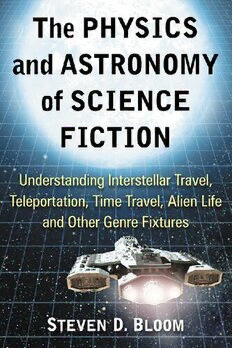
The Physics and Astronomy of Science Fiction: Understanding Interstellar Travel, Teleportation, Time Travel, Alien Life and Other Genre Fixtures PDF
Preview The Physics and Astronomy of Science Fiction: Understanding Interstellar Travel, Teleportation, Time Travel, Alien Life and Other Genre Fixtures
The Physics and Astronomy of Science Fiction This page intentionally left blank The Physics and Astronomy of Science Fiction Understanding Interstellar Travel, Teleportation, Time Travel, Alien Life and Other Genre Fixtures Steven D. Bloom McFarland & Company, Inc., Publishers Jefferson, North Carolina LIBRARYOFCONGRESSCATALOGUING-IN-PUBLICATIONDATA Names: Bloom, Steven D., 1965– author. Title: The physics and astronomy of science fiction : understanding interstellar travel, teleportation, time travel, alien life and other genre fixtures / Steven D. Bloom. Description: Jefferson, North Carolina : McFarland & Company, Inc., Publishers, 2016. | Includes bibliographical references and index. Identifiers: LCCN 2016006850 | ISBN 9780786470532 (softcover : acid free paper) ♾ Subjects: LCSH: Science fiction—History and criticism. | Physics in literature. | Astronomy in literature. | Science fiction films— History and criticism. | Science fiction television programs— History and criticism. | Science in motion pictures. Classification: LCC PN3433.6 .B58 2016 | DDC 809.3/8762—dc23 LC record available at http://lccn.loc.gov/2016006850 BRITISHLIBRARYCATALOGUINGDATAAREAVAILABLE ISBN (print) 978-0-7864-7053-2 ISBN (ebook) 978-1-4766-2399-3 © 2016 Steven D. Bloom. All rights reserved No part of this book may be reproduced or transmitted in any form or by any means, electronic or mechanical, including photocopying or recording, or by any information storage and retrieval system, without permission in writing from the publisher. Front cover image © 2016 Sylphe-7/iStock Printed in the United States of America McFarland & Company, Inc., Publishers Box 611, Jefferson, North Carolina 28640 www.mcfarlandpub.com To my wife, Jennifer, and our daughter, Aviva, with love This page intentionally left blank Table of Contents Preface 1 1. Introductory Physics 5 2. Introduction to Astronomy 25 3. The Physics of Space Travel 63 4. Universes, Dimensions and Space 99 5. Time Travel 121 6. Computers, Robots, Androids and Cyborgs 141 7. Teleportation and Replication 160 8. Weaponry 167 9. Extraterrestrial Life 180 10. Super- Human Powers 204 Chapter Notes 217 Bibliography 221 Index 229 vii This page intentionally left blank Preface Science fiction films, television, books and short stories have been pop- ular for decades and have, since their onset, relied on science and technology for their core concepts. With rocketing to the stars, time travel, planet busting weapons and sentient robots, it’s no wonder that they especially have relied on topics from physics and astronomy, and often from the cutting edge of these fields. Many fans have shown an interest in which concepts are possible (such as interstellar travel, time travel, teleportation or androids). In addition some fans have shown an interest in the basics, such as the background physics behind how a rocket works or how a star creates energy. Many books have been published on a select few of these topics (such as Michio Kaku’s Physics of the Impossible and Physics of the Future), but usually only have a couple of specific examples from science fiction (often just from Star Trek). Several more comprehensive books have been published on these topics over the years. One of these is over 30 years old and needed serious updating in both the physics and the popular cultural references (Amit Goswami’s Cosmic Dancers). An excellent recent book, especially for those with a solid intro- ductory physics and mathematics background is Charles Adler’s Wizards, Aliens and Starships. His discussion of the physics of flight and space travel is particularly extensive. However, he is not reserved in placing equations (including calculus) directly in the main text, so this may be a difficult text for the more casual reader. Another very recent offering, Barry Luokalla’s Exploring Science through Science Fiction, is intended as a college textbook and is a little more general than what I have intended (touching on some other sciences, such as biology, which I only discuss minimally in this work). So, where do I fit in to this picture? On July 20, 1969, on my fourth birth- day, my parents unexpectedly placed my twin brother and me in front of our family television set, which at the time was a w ell-w orn black and white model. Though, like many pre- school children, I didn’t mind watching tele- vision, this was something other than what I was used to. We were watching a grainy transmission of something. I didn’t quite understand what I was 1
